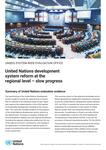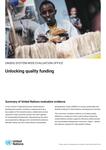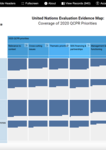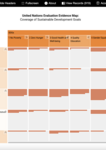Page Header

Overview
This evaluation evidence map was prepared by the UNSDG System-Wide Evaluation Office (SWEO). It aims to improve access to the extensive evaluation evidence generated by UN entities in the context of system-wide and intergovernmental policy discussions.
The map features 783 evaluations published by UN system entities between January 2021 and April 2024. The columns are 24 priority areas derived from the 2020 QCPR (A/RES/75/233) spanning strategic, thematic and cross-cutting issues, as well as development system management, functioning and funding. The rows are different types of evaluations, including global, regional, country and emergency response, as well as joint programmes and pooled funding. Existing syntheses and summaries of evidence from multiple evaluations are also included.
Evaluations were tagged to a QCPR priority area only if it was a central focus of the report with relevant and detailed analysis throughout. A separate map which tags evaluations with more limited analysis relevant to the topic is also available within this series (blue colour scheme).
The classification of evidence to create the map and the drafting of evaluation abstracts was achieved through an innovative and iterative methodology of human-artificial intelligence (AI) collaboration, using a large language model. Iterative testing and quality assurance throughout the development process provided a relatively high level of confidence in the classification. However, inaccuracies and errors (of inclusion or exclusion) may still be present.
This map has been developed as a pilot exercise and can be considered as a proof of concept for further exploration of the use of AI for UN system-wide evaluation evidence mapping and summaries.
Report Details
| Year Published | |
| Type | |
| Joint | No |
| Partner/s | N/A |
| Consultant name | |
| Agency Focal Point | Tom Barton |
| Focal Point Email | thomas.barton@un.org |
| Managed by Independent Evaluation Office | Yes |






